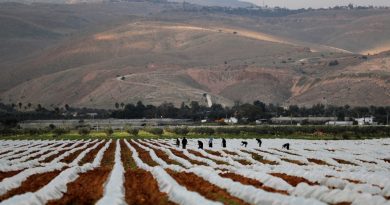From pollution to power: Canada’s first Indigenous-owned bioenergy facility opens
As the temperature dips to -28 C, Paul Opikokew is ready for the unexpected at the newly-built Meadow Lake Tribal Council Bioenergy Centre in northwestern Saskatchewan, now being tested by its first winter in operation.
Opikokew, 44, a process operator, monitors 980 alarms on a computer system that tracks every part of the $100-million facility — from the wood chips coming in from the nearby sawmill to the power going out to roughly 5,000 homes.
“It’s something new, something that I’m excited about because it’s new technology and good for the environment,” Opikokew told CBC News during an interview at the facility located on the outskirts of Meadow Lake, 250 kilometres northwest of Saskatoon.
Opikokew, who grew up at Canoe Lake Cree Nation, is thrilled that NorSask Forest Products, the largest First Nations-owned sawmill in Canada, is ditching a dirty habit.

Half century of spewing smoke and ash
For 50 years, the sawmill has simply burned its wood waste — including bark, wood chips, and sawdust — in what’s known as a beehive burner. The free-standing conical steel structure, notorious for air pollution, has been phased out or banned in most parts of Canada. Yet, NorSask Forest Products continued to dump 56,000 tonnes of leftover wood inside the antiquated incinerator, spewing out smoke and ash.
The Meadow Lake Tribal Council (MLTC), made up of nine First Nations in northwestern Saskatchewan — including Opikokew’s band — became a part-owner of the NorSask sawmill in 1988, then the sole owner in 1998. And while it has prided itself on generating jobs and revenue for its communities, the beehive burner has been a nagging stain on its environmental record.

Tina Rasmussen, the chief business officer for MLTC and a member of Flying Dust First Nation, said elders, in particular, expressed their discomfort with wasting a quarter of each tree harvested from traditional land.
The bioenergy centre changes that.
“[Wood waste] is now being combusted in a closed-loop system that produces both combined heat and energy that allows us to make use of 100 per cent of that tree. So it’s incredible. We’ve fulfilled what our communities have expected, which is making use of that resource. If you’re taking it, then you need to use it all and not waste it.”
“It’s pretty amazing,” she said, “that this whole facility is 100 per cent Indigenous-owned.”
Any time wood is burned, it produces greenhouse gas emissions. However, the bioenergy plant uses air pollution control devices, including a filter to remove particulate matter and extremely high combustion temperatures that break down harmful pollutants into ash that’s sold to farmers.
Rasmussen and others argue that replacement forests will gradually soak up any carbon dioxide emitted when the wood waste was burned for energy, making the whole process carbon neutral.
Not all bioenergy facilities are universally celebrated. Those that harvest trees for the sole purpose of creating wood pellets to generate electricity have faced mounting criticism, both for what is happening in the forest and for the carbon emissions produced by burning the pellets. However, this facility uses leftover wood from trees that were already cut down for lumber that’s used to build homes or furniture.
Electricity for roughly 5,000 homes
Our CBC News crew was the first to be shown the bioenergy facility, now operational after months of delays.
Through a small window, it’s possible to see into the blazing red combustion chamber, where temperatures reach nearly 1,000 degrees C. The fire slowly heats tubes that are filled with thermal oil, and that heat energy is converted to electrical energy.
The MLTC Bioenergy Centre generates 8.3 megawatts of power, 6.6 of which is fed into the provincial grid, purchased by SaskPower, and used to power roughly 5,000 homes. The rest of the energy runs the bioenergy centre and heats a sawmill kiln that dries lumber.

Clean energy project not cheap, easy, or quick
The MLTC began exploring the idea of a biomass power plant in 2008.
Its goal was to phase out its beehive burner, generate carbon-neutral green power, and create jobs and revenue for its nine First Nations.
In 2012, the Harper government announced $499,000 in federal dollars to cover project design and environmental assessments. At that time, the proposed facility was expected to generate 36 megawatts of clean energy, enough to power roughly 30,000 homes. It would take another seven years to get to the point in 2019 that Trudeau’s government approved $52.5 million from its Investing in Canada green infrastructure program for a scaled down version of the project.

“The project is expected to decrease greenhouse gas emissions by more than one million tonnes over 25 years, and reduce smoke and other harmful matter to significantly improve air quality for residents,” said a Government of Canada release from that announcement.
The pandemic and supply-chain issues inflated prices, driving the total cost just above $100 million, and added delays to construction and commissioning. The facility was initially slated to open in February 2022, but didn’t get running until late October.
Of that total price, about $35 million in contracts went to Indigenous companies, according to Al Balisky, who oversees all of MLTC’s investment projects.
“Indigenous participation, in terms of ownership, in terms of construction and now in terms of operation … from start to finish was the goal and we’ve achieved that,” said Balisky, adding that seven of 13 employees are Indigenous.

Balisky said the “biggest challenge” was getting the money to “pull it all together.” He said it wouldn’t make commercial sense for a private company to pursue this kind of clean energy project without taxpayer funding.
“These are very expensive projects to undertake so without that assistance, this project would not have happened,” he said.
The MTLC business team says it hopes the bioenergy facility will yield profits over time that can be returned to their communities to support health, education and housing programs.



